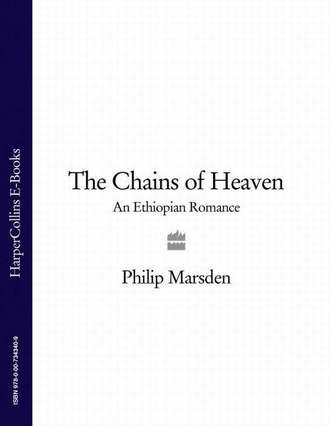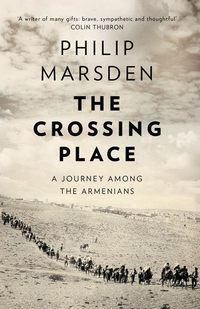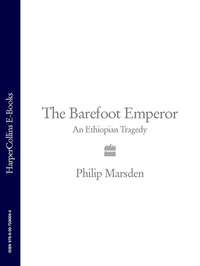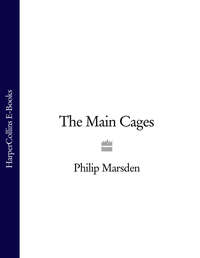
Полная версия
The Chains of Heaven: An Ethiopian Romance
‘What was that?’
‘Hauled sixty of those out of the cellar beneath the throne room and shot them. I was in New York when I heard. Resigned at once.’
Two days later, through a coffee merchant, I was introduced to the emperor’s grandson. Prince Ba’eda Maryam Makonnen had a business importing coffee machines. He was an ordinary looking Ethiopian in a zip-up cardigan—but on his index finger he wore a signet ring with a gold relief of a lion and staff, the Conquering Lion of the King of Judah.
Ba’eda was the son of Haile Selassie’s favourite child, the Duke of Harar, who had been killed in a car crash when Ba’eda was only fourteen days old. With his brothers and sisters he had then gone to live with his grandfather in the Jubilee Palace. Later he was one of those imprisoned in the Ghibbi, the Grand Palace.
‘When we were in prison Mengistu came to see us. He was always very polite. He called my grandfather Getay—master—and always made sure to salute him.’
In the end Ba’eda was moved to the cellar beneath the throne room. He passed me on to another of its inmates. I went to see Teshome Gabre-Maryam on a warm, sunny afternoon. He had served in the emperor’s government and was now a prosperous lawyer. He worked in an office in the leafy compound of his home. When I arrived he was with another man, General Negussie Wolde-Mikhael.
Thirty years of power shifts had seesawed the lives of these two men. They had both begun their careers under the emperor. They were both high-fliers: Teshome had helped draft the constitution, General Negussie was chief of police in Addis. But when the Derg came, it had imprisoned one and promoted the other. While Teshome counted off the months and years in the palace cellar, General Negussie was made Chief Justice of the Martial Court.
‘One day, they took me for trial,’ explained Teshome. He reached out and, with a smile, took the general’s hand. ‘Who was there presiding in the court?’ He raised the general’s hand. ‘He could have had me executed!’
‘Why did you let him off?’ I asked, smiling.
The general glanced at Teshome. ‘He was a lawyer. He stood up in the court and convinced me.’
‘That he was innocent?’
‘No—that the court had no validity.’
Teshome laughed. He was still holding the general’s hand.
Teshome was released, and when the Derg fell General Negussie himself was imprisoned. He had only just been released. Now Teshome was helping him; he had given him a car.
‘Did you approve of the Derg?’ I turned to General Negussie.
‘To begin with, I was very happy with the ideology. We really believed it would help Ethiopia. But for me it changed completely when they executed my uncle. I was so filled with anger—I wanted to kill every one of those Derg men. My colleagues suggested I apply for a transfer. They probably saved my life. For six and a half years I was administrator of Hararge region. Then in 1982 the Derg asked me to become a minister—Minister without Portfolio.’
‘Did you accept?’
He shrugged. ‘I had ten children.’
‘What do you remember of Mengistu?’
‘Very moody. Very violent. My office was just above his and I could always hear his shouting. The only quality I know he had was that he loved his country. Also he was not corrupted at all. He was very honest with money. And he was very good at listening. He always knew exactly what the important point was.’
‘Did you admire him?’
He looked at me. Prison had greyed his hair; his face was soft and troubled. ‘Every day I was with Mengistu, I was thinking: how can I kill this man? We were always searched before going to our office. But when I was alone with him I would watch him and think how could I do it—he was a small one and I am a judo expert. I travelled with him to different provinces and I sat behind him on the plane looking at the back of his head and he had one little scar just here—’ the general leaned forward and tapped the top of his neck ‘- and I was thinking, that would be the place, that would do it. A bullet just there…’
General Negussie stood and said goodbye. He walked stiffly to the door. For a moment after he had gone, Teshome and I were silent. A yellow weaver bird was pecking at the windowpane—tap-tap…tap-tap-tap.
Teshome and I carried on talking. I told him about my first trip to Lake Tana, about Wonderland Tours and Teklu and Dr Mengesha.
‘Mengesha Gabre-Hiwot?’
‘Yes.’
‘I was brought up with him! We were classmates at Tafari Makonnen school. He helped me. He gave me money when I came out of prison in September 1982.’
‘That was a few weeks after I was here.’
The weaver bird was again tapping at the window— sparring with an aggressor that matched him blow for blow.
Teshome pursed his lips and let out a long, frustrated ’Dhaaaaa…’ for all the shattered years, the Derg’s brutalities, the squandered hopes of his own generation.
‘Do you know what happened to him, Teshome, why he was detained?’
‘Do I know?’ He looked at me blankly, then nodded. ‘They said he read and distributed some anti-Derg literature.’
‘Did he?’
‘Actually he did, yes. In fact he showed it to me and I was very nearly imprisoned again as a result. It was also a time that the TPLF was advancing—so of course Tigrayans were not that popular.’
The weaver bird was still attacking its glass opponent—tap-tap…tap-tap-tap…
‘What happened in the end?’
‘They tortured him. He got gangrene in his leg—they had to amputate it. The gangrene was also in the other leg, and they had to amputate that one too. In fact, he was given permission to go home. But someone apparently said: What will people say when they see him with no legs? Much easier to kill him. They took him to a place on the edge of Addis known as “Bermuda”—the Bermuda Triangle. When people went there they nevercame back. They killed him there.
‘Mengesha was one of the best, one of the most decent individuals you could ever imagine.’ Teshome pressed his fists hard on the desk. For a moment he looked overwhelmed by his own anger. ‘That was the worst of it. They took men like that and destroyed them. Those animals.’
I had kept an image in my mind all those years, an everyday Ethiopian image glanced from a bus window. It was of a farmer, bare-legged, his dula flexed across his shoulders, setting off on a narrow path across the plateau.
Ethiopia taught me many things. As a naïve twenty-one-year-old, with years of flunked schooling behind me, I was ready for the simplest of lessons. Instead I was presented with paradoxes. I learnt of the cruelty that could be perpetrated in the name of a good idea. I saw how a people hurtling towards catastrophe, hungry, with population growth out of control, could go on living day to day with such astonishing grace. I saw how those apparently ignored by divine goodness could still apply their greatest energy to worship. I learnt that the human spirit is more robust than life itself.
Ethiopia opened my eyes to the earth’s limitless range. I pictured the country’s startling scenes and stories multiplied across the globe, then factored up by the past. It made the notion of ‘a small world’, ‘a shrinking world’, look absurd, and it made me restless.
Ethiopia instilled in me the habit of a lifetime, the habit of travel. It revealed the rewards that can be had simply from being footloose among strangers, from taking remote and narrow paths with bare-legged farmers. It bred in me the conviction that if there is any purpose to our time on this earth, it is to understand it, to seek out its diversity, to celebrate its heroes and its wonders—in short, to witness it.
There is a saying in Ethiopia: ‘Kes be kes inculal bekuro yihedal‘ (’Step by step the egg starts walking’). My Amharic teacher would use it whenever I showed signs of frustration. I was a hopeless pupil; he used the expression very often. But now, after twenty-one years, the egg was hatching. I would go north into the roadless heart of the country, set off across the plateau. I would go to the places first conjured up by Teklu that afternoon in Mengistu’s stifled city, with the rain hammering on the tin roof. I would go to Lalibela, to the sacred city of Aksum, and I would walk between them.
‘Walk?’ spluttered an Ethiopian friend. ‘You can’t walk! Foreigners don’t walk.’
Walking was what villagers did. They walked and walked, to find grazing, to church, to market, to clinics. Until the nineteenth century wheels were unknown in the highlands. They still are in most places—no barrows, no carts; just legs and shoulders and mule-backs and the glimpse of a government or NGO’s 4×4 as it races by, leaving you coughing in its dust-wake.
I made plans. I began the Ethiopian game in which information, misinformation and pure fantasy are all cunningly dressed up as each other. With such distances, I asked, might it be better to ride? Yes, ride, ride—on a horse! No (there are no horses, not up to the terrain). Should I go alone? Yes, yes—all alone! No (suspicious villagers would march you straight into the first town). Is it safe? (Very safe, no bandits/you will need one unit of armed guards). Is there food? (No food/lots of food). The truth was that no one knew anything other than a couple of the towns on my route.
I found a tent, bought a kerosene stove and stocked up with packet soup and sardines. I tracked down a Tigrinya-speaking guide named Hiluf in Aksum; I asked him to take a bus and meet me in Lalibela. I prised a map from the appropriate government agency.
One morning, I climbed the hill to Giorgis cathedral. It was not yet eight. The crowds were flooding up past the equestrian statue of Emperor Menelik. We were pressed closer and closer together, swept forward on an unstoppable tide. The octagonal church rose from a mass of white gabbis. All around me people were in various states of rapture. Some men were dancing. Others bowed their heads. Women stood in tears. From the steps, a flop-haired hermit delivered a eulogy to the dual virginity of Mary: ‘There is nothing that equals her glory. She is higher than all creatures, men as well as angels! Her dress is the sun with the moon beneath her feet…‘ Amputees dragged themselves among the worshippers’ legs. A group of boys had climbed into the trees to watch. It could have been the fifteenth century, or any century.
Giorgis cathedral was the first place I ever saw the spectacle of Ethiopian worship. I had come here with Teklu on my second day in Addis. After a lifetime of sober grey churches and bloodless rite, I was astonished. Christianity to me was something dusty and ossified, but not here. Over the years, the Ethiopian Church came to distil for me all that was extraordinary and ageless about the country. After my first visit, I thought you only had to step out over the threshold of Europe to be faced with such a sight. Now I know that that is only partly true. There is nowhere else on earth quite like Ethiopia.
The next morning, with 130 pounds of equipment and food, I flew to Lalibela.
3
An hour before dawn and Lalibela’s rock-cut trenches are dark as oil. Their high sides rise to a narrow strip of stars. Underfoot the tufa is rough and pitted. I steady myself with a hand on the cold walls. The night air is sharp against my nostrils. Along the tunnel from the church of Debra Sina comes the nasal sound of chanting. Each phrase lasts a minute. Then—boooom!—the first beat of the kebbero. It is a sound like no other. It strikes you somewhere deep in the thorax. Another beat, and I quicken my pace.
Far below ground level, the base of the church rises from its own plinth of bedrock. Sandals are heaped by the door. Light glows from keel-arch windows. Inside is warmth, the smell of an all-night presence. Dozens of people are wrapped in white gabbis. Some are no more than shapes on the floor; others are standing heron-still around the central bay. On sturdy columns can be seen the chisel-cuts in the rock. The columns rise to shallow cupolas. Far beneath them two drummers squat beside their kebberos. Slowly, alternately, with the flat of their hands, they are beating the goatskin tympana.
The debtara are standing over them. They are elongated figures in white turbans and hanging white shawls. They are chanting. The drums beat, the debtara drop their wrists and their handheld sistra rattle like coins.
One of the drummers gives a quick, double bo-boom! The other follows. The tempo increases. One by one the shapes rise from the floor. In two lines the debtara shuffle towards each other. Their prayer sticks cluster above them. At the exact moment they begin the dance, a blind cantor steps to the front, his mouth open in song. He is wearing a pair of women’s dark glasses. The drummers are standing now. Each kebbero hangs from a shoulder-strap. They circle each other. They give two more double beats. Rhythmic clapping spreads through the church. One of the drummers leans to the right, the other to the left. Now they are spinning. They are crouching, rising. Their faces glow with abandon. The people press closer around them. The cupolas fill with ululations. The drummers’ eyes flash in the half-light. The debtara are swinging the prayer sticks now, surrounding the drummers in their ecstasy of beating. A young boy joins their line, his head level with the men’s hips. He is imitating their movements.
Out of nowhere, a man leaps into the midst. His matted hair swings from side to side. He dips his cross-staff above his head. His movements are fluent and precise. A grin splits his skull-like face. The boy has stopped dancing. He is standing still, buffeted and jostled by those around him. He is staring at the man, and his eyes are wide with fear and amazement.
No force on earth could stop this. The man is revolving around the drummers. Sweat flicks from his hair. Deep below
the ground, the hollowed-out chapel is filled with drumming, filled with clapping, filled with ululating, and it all merges in a fever of sound and movement and devotion.
Then it is over. The drummers are lifting the kebberos over their heads. The debtaras‘ sistra tinkle as they set them down. Two priests are involved in a hissed argument, flicking through a psalter. The shapes on the floor are re-forming themselves. The man with matted locks has disappeared.
Outside again, dawn is a pale loom above the trench. It is still cold. From the distance comes the sound of a tirumba, the funereal horn—and a cry: ‘Citizens of Lalibela! Come out—come out! Come and help bury the body of Colonel Melaku. Citizens of Lalibela, come out, come out!‘
Lalibela is a town to die in. The tunnels that once linked the complex of churches are clogged with centuries of corpses. To make a pilgrimage to Lalibela eases your later passage to heaven—but to die here is much better. The soil itself is sacred, and those who take the journey are buried in shallow graves.
The site has never been conclusively dug by archaeologists. Scholars know by heart the handful of significant written references to it. It is easier to list what is not known about Lalibela than what is. It is not known precisely when the churches were carved, whether they were started during the thirteenth-century reign of King Lalibela or much earlier. Nor is it known where all the excavated rock was deposited, nor if any outside expertise was responsible. Nor why, deep in the mountains of Lasta, the Herculean task of chipping out these eleven churches and their labyrinth of link trenches was undertaken. Like Ethiopia itself, it is a timeless place, veiled by layer upon layer of mythologies.
The town’s earlier name of Roha is linked perhaps to al-Ruha, Arabic for the holy city of Edessa which was lost to the Christians just before the reign of King Lalibela. Then again it was the heir of the holy city of Aksum, believed by Ethiopians (never shy in their myth-making) to be Zion itself. So Lalibela took on something of the aura of Aksum and Zion, and thereby of the holiest of all earthly places, Jerusalem. King Lalibela himself was taken on a dream-tour of Jerusalem by the Angel Gabriel and was able to replicate its sites. Pilgrims therefore needed to go no further than Lalibela to earn God’s favour.
The yearning for Jerusalem has haunted generations of Ethiopians—a yearning amplified by its extreme risks. Wild animals, pirates and Muslims have combined in the imagination of Ethiopian Christians to create an über-threat for all those daring to leave the mountains. In the eighteenth century Queen Mentuab wailed to James Bruce that, after thirty years on the throne, she would give up everything if only she ‘could be conveyed to the church of the Holy Sepulchre in Jerusalem, and beg alms for my subsistence all my life after’. Jerusalem was where it all began for Ethiopian kingship, where the union of Solomon and Sheba took place and from where Menelik I acquired the Ark of the Covenant, dancing before it like King David.
So Lalibela became a Biblical Land in miniature. Here is Golgotha, Cana and Nazareth. Beneath Calvary is the Tomb of Adam. I had skirted the slopes of Mount Tabor, Mount Sinai, crossed the River Jordan and climbed the Mount of Olives. In the compound of Beta Maryam, I had bent to smell the single rosebush from the Garden of Eden. Beside the church of Beta Giorgis is a slope of un-dug rock which is Mount Ararat.
Lalibela carries with it a weighty cargo of symbolism—not a place for the literal-minded. It made me think of Robert Southey’s comment after once visiting William Blake: ‘Blake showed me a perfectly mad poem called Jerusalem,’ he reported. ‘Jerusalem is in Oxford street!’
It was a lovely morning. A few high clouds drifted in a clear blue sky. I passed the fresh grave of Colonel Melaku, where a mound of stones covered his body. An olive-wood cross rose at one end, and on it was nailed a crude plaque: Colonel Melaku Fetem born 1935 EC died at 61. The wreath of marigolds and mimosa was already wilting in the heat.
I was on my way to see a bahtawi. A churchman in Addis had given me the name of Abba Gabre-Meskal. ‘He may be there or—’ the churchman dropped his voice—‘he may have already vanished.’
I was in luck. I found him up a dusty alley, sitting outside his own lean-to. He was stitching a patch into his qamis, his anchorite’s shawl, dyed yellow (the Ethiopian monks use for this yellow the native plant Carthamus tinctorius, or ‘bastard saffron’). I sat on a stool opposite him and, as I tried to read the wrinkles of his cheek, asked if he knew anything about the dead colonel.
‘Colonel Melaku? He was my neighbour. Very religious man. He came to Lalibela for his death. He was a Derg colonel.’
‘But the Derg were against the Church?’
‘The Derg were devils! Some of the top ones, they just kept it hidden—they prayed in private.’
Abba Gabre-Meskal was pleased by the thought, and a smile spread across his weathered face. The smile became a chuckle, and the chuckle became a cough—and the cough bent him in two. During the last rains, pneumonia had forced him down from the mossy cave where he had lived for ten years. I offered him water. He drank it in short sips. I didn’t want him vanishing on me.
He was a tall man. He had deep-set eyes and skin like oxhide. His expression swung between comic innocence and holy rage. He raised the yellow qamis to his face to examine his stitching.
‘You a Christian?’
‘Of sorts,’ I said.
‘Protestant?’
I nodded.
‘Luther, Luther!’ He was sewing with quick, even stitches, even though he could hardly see. ‘Tourist?’
‘Yes. I’m going to Aksum. On foot,’ I added, for effect.
He wasn’t impressed. ‘Tell me, have you ever heard of a place called Jerusalem?’
I told him I had lived for a time in a monastery in the Old City.
Leaning down to gnaw through the thread, he looked at me properly for the first time. He folded the qamis and put it to one side. He laid his hands together in his lap, drew a big breath and, for an hour or more, captured me with a long and beautiful story about his own attempt to reach Jerusalem.
Abba Gabre-Meskal had begun his career at a religious school in the Gondar region. One day a fellow student died. The memhir called everyone together and said: ‘One of our brothers has died suddenly. Something is not right.’
They agreed that it was a punishment from God. It made them uneasy because they did not know what they had done wrong, and they couldn’t tell what would happen next.
‘We must make a pilgrimage,’ the memhir said. ‘Someone must go to Jerusalem, without shoes.’
A senior monk was chosen as leader and two others appointed to go with him. Young Abba Gabre-Meskal was one of them. They took with them the Psalms of David, a Book of Hours and gourds for water.
‘We set off with our faith. We put our trust in the will of God.’
They had no shoes.
In Tigray they came to the palace of Ras Seyoum. At the gates were many people—the sick, the poor and the needy. But the pilgrims’ leader was a well-known monk and Ras Seyoum himself came down to see him.
‘What are you doing?’ he asked.
‘We are going on a pilgrimage. One of our brothers died.’
The ras asked the monks to say a prayer for him at the church of the Holy Sepulchre. He gave them thirteen silver Maria Teresa thalers. The monks went on their way. They reached the border to the Sudan, and on the other side, the soldiers arrested them.
‘You are spies!’ they said.
‘We are not spies,’ explained the monks. ‘We are pilgrims on our way to Jerusalem. Look, we have no shoes.’
But the soldiers put them in the prison. They stayed there for a month and then the monks heard the soldiers say: ‘Perhaps these men are not spies. They have no shoes.’
So the monks were released. They carried on through the desert. It was a very difficult time. They found only salty water and the ground was hard and stony. One day a stranger came up to them and said: ‘Why do you walk without shoes?’
‘We are pilgrims. We are going to Jerusalem.’
‘Look,’ he said, pointing to the distance. ‘There is a train. I can ask it to stop and then you can travel easily to your destination.’
They looked at the train. They saw the long line of carriages and the white trail of smoke above it. They saw its round spinning feet and they realised the man beside them was Satan, sent to tempt them.
‘Go away!’ they shouted, and he disappeared.
Sometimes they followed the Nile and sometimes they were in the desert. They reached the border to Egypt and on the other side of the border the soldiers arrested them.
‘You are spies,’ they said.
‘We are not. We are holy men. We have no shoes.’
The soldiers saw that it was true. But then one of the soldiers said: ’Be careful—they may be extreme believers!’
So the soldiers put them in prison for being extreme believers. They spent months in that Egyptian prison. Abba Gabre-Meskal said the prison wasn’t too bad. It reminded him of the monastery. He did not mind being locked up, the poor food, the crowding. What he did not like were the rats. In the end the Egyptians released them and they carried on. They came to a famous place. It was, said Abba Gabre-Meskal, a great piece of water between Egypt and Lebanon. They stood by the water and they realised they could not cross it. They were very sad, but thought: It is not the will of God that we reach Jerusalem.
‘Our leader said he would stay. He would wait to try and cross the water. But we decided to go home. It was the end of the journey.’
Abba Gabre-Meskal rose to his feet. He fetched a bowl of kolo, roasted corn.
‘There is one more interesting thing.’ He stood high above me, the sun behind his head and one finger pointing at the sky.






